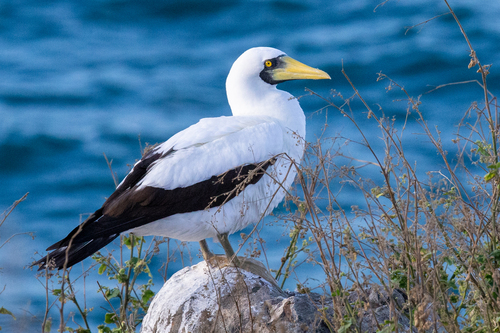
Masked Booby
The Masked Booby (Sula dactylatra) is a large seabird known for its distinctive facial markings, which resemble a dark 'mask'. It plays a vital role in marine ecosystems as a top predator, helping to regulate fish populations. This species is widespread across tropical oceans, often nesting on remote islands. While not currently globally threatened, localized populations face challenges from habitat loss and introduced predators. Culturally, Masked Boobies have been featured in the folklore of some island communities, often symbolizing resilience and freedom.
74-91 cm
Length
137-165 cm
Wingspan
Least Concern
Conservation Status
Distribution
The Masked Booby is found throughout tropical oceans worldwide, including the Atlantic, Pacific, and Indian Oceans. It breeds on islands and atolls, and its non-breeding range extends widely across open ocean waters. Migration is limited; most birds remain relatively close to their breeding colonies year-round, although some dispersal occurs.
Lifespan
15-20 years (wild); potentially longer in captivity (Not Evaluated)
Masked Booby's Habitat
Habitat Types
Tropical and subtropical islands, Coral atolls, Open ocean (foraging)
Climate Zones
Tropical, Subtropical
Adaptations
Masked Boobies have streamlined bodies and long, pointed wings for efficient soaring and diving. Their webbed feet are adapted for swimming, and their serrated bills help them grasp slippery fish. They also possess salt glands to excrete excess salt consumed with their prey.
Variations
Several subspecies are recognized, differing slightly in size and plumage. For example, *Sula dactylatra personata* is found in the central and western Pacific, while *Sula dactylatra dactylatra* is found in the Atlantic.
Appearance
Breeding Plumage
Adult plumage is primarily white with black flight feathers and a black tail. The 'mask' is a dark area of bare skin around the eyes and bill. There is little difference between breeding and non-breeding plumage.
Seasonal Feather Changes
No significant seasonal variation in plumage.
Sex Based Plumage Differences
Limited sexual dimorphism; females may have a slightly yellowish bill during breeding, while males often have a brighter yellow bill.
Notable Features
Dark facial 'mask', Sharp, serrated bill, White body plumage, Black flight feathers and tail
Diet and Feeding
Primary Foods
Small fish, Squid
Foraging Behavior
Masked Boobies are plunge divers, spotting prey from the air and diving into the water with incredible speed and accuracy. They can dive from heights of up to 30 meters. They often forage in groups, sometimes following schools of predatory fish or dolphins that drive prey towards the surface.
Specializations
Their streamlined bodies and powerful wings allow for efficient diving. Their serrated bill helps them secure their slippery prey.
Seasonal Diet Variations
Diet may vary slightly depending on the local availability of prey, but generally remains consistent year-round.
Behavior
Social Structure
Masked Boobies are colonial breeders, nesting in groups that can range from a few pairs to thousands of birds. Outside of the breeding season, they are more solitary or found in small groups.
Communication
Vocalizations include grunts, croaks, and whistles., Visual displays, such as sky-pointing and bowing, are used during courtship and territorial disputes.
Migration
Generally non-migratory, but may disperse widely from breeding colonies in search of food.
Territorial or Group Behaviors
They defend a small territory around their nest site. Aggression is common within colonies, especially during the early stages of breeding.
Conservation
Threats
Habitat destruction (loss of nesting sites), Introduced predators (rats, cats, on islands), Overfishing (reducing prey availability), Plastic pollution (ingestion and entanglement), Climate change (sea-level rise, changes in prey distribution)
Protection Programs
Protection of breeding colonies on islands, Eradication of introduced predators, Marine protected areas (to safeguard foraging grounds)
Local National Laws
Protected under various national and international laws, including the Migratory Bird Treaty Act in the United States.
Population Trend
Stable
Population Estimates
The global population is estimated to be in the hundreds of thousands, but precise figures are difficult to obtain.
Interesting Facts
Masked Boobies are expert divers.
They can plunge into the water from considerable heights to catch their prey.
Siblicide is common in Masked Booby nests.
The older chick often kills its younger sibling, ensuring its own survival when food is limited.
They have a specialized nictitating membrane.
It is a transparent or translucent third eyelid that can be drawn across the eye to protect it. They use it when they are underwater.
Faqs about Masked Booby
Where can I see Masked Boobies?
Masked Boobies are found on tropical islands throughout the world. Popular locations include the Galapagos Islands, the Caribbean, and islands in the Pacific and Indian Oceans.
What do Masked Boobies eat?
They primarily eat small fish and squid, which they catch by plunge-diving.
Are Masked Boobies endangered?
No, they are currently classified as Least Concern by the IUCN, but some local populations are threatened by habitat loss and introduced predators.
Copyright @ Nature Style Limited. All Rights Reserved.
 English
English